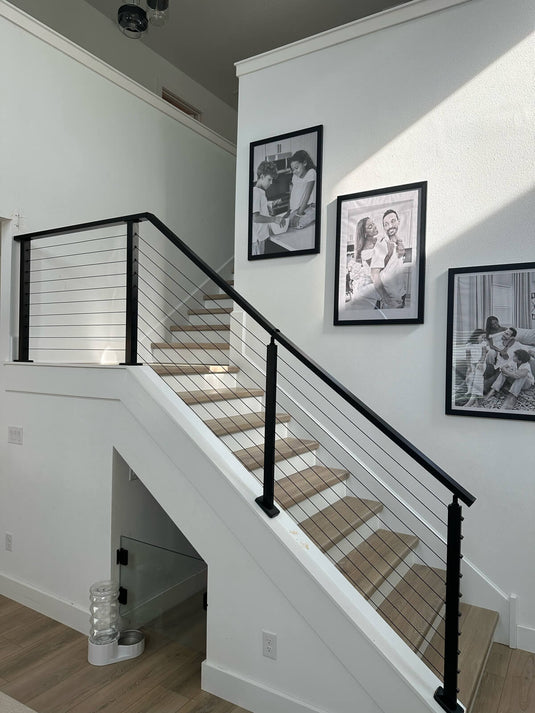TABLE OF CONTENTS
How to Design Stairs to Prevent Pets From Slipping Or Getting Injured?
For our pets, stairs can be a dangerous barrier since they often struggle with traction and height phobia. Stairs must be designed with pet safety in mind if one is to avoid trips, falls, and accidents. From examining the particular needs of various pets to choosing the appropriate materials and including design aspects that give their well-being top priority, this article will discuss doable advice and tactics to make staircases more pet-friendly. These ideas will enable you to design a safe and comfortable space for your cherished pets, whether you are repairing an old staircase or building a new one.

Pet Behavior and Needs on Stairs
When it comes to negotiating stairs, pets—especially dogs and cats—have distinct physical traits and behavioral patterns that are different from humans. Unlike ourselves, our pets mostly rely on their paws and claws to grab the steps; thus, traction is quite important for their comfort and safety.
Cats, with their natural agility and climbing instincts, may find stairs less challenging than dogs. However, they can still struggle with fear of heights, particularly on open or steep staircases. Dogs, on the other hand, often face greater difficulties due to their size, weight distribution, and limited dexterity. They may have trouble maintaining their footing, leading to slips, slides, and even serious injuries.
Smaller pets may also find it difficult to climb too tall stairs; aged or disabled animals might lack the power and coordination needed to securely negotiate stairs. Designing stairs requires careful consideration of these physical restrictions to guarantee your pets may climb and descend with confidence and ease.
How Can Stair Materials and Surfaces Affect Pet Safety?
The materials and surface textures used in pet-friendly stair design are quite important. Various stair materials can have rather diverse effects on a pet's capacity for safe gripping and maneuverability.
Pets may find especially dangerous smooth, slippery surfaces such as glossy tiles or hardwood since they struggle to keep traction and may slide or lose their footing. For our dogs, textured or patterned materials—like non-slip rubber treads or carpeted stairs—offer significantly better grip and stability.
Matte or slightly rough textures provide more friction and better paw grip compared to glossy or highly polished finishes. Additionally, the use of contrasting colors or patterns on the stair edges can help pets better identify each step, reducing the risk of missteps or confusion.

Stair Design Strategies for Pet Safety
When designing stairs with pets in mind, the dimensions of the treads and risers play a crucial role in ensuring their safety and comfort. Experts recommend tread depths of at least 11 inches and riser heights no more than 7 inches to accommodate the varying needs of different pet sizes and breeds.
Apart from the stair proportions, the addition of handrails or side walls can give pets negotiating the steps necessary support and direction. These characteristics give dogs a sense of protection; they enable pets to get ready and feel more confident as they climb and down.
A pet-friendly stairway also depends much on consistency and appropriate illumination. Pets can create a clear mental map of the location by keeping consistent step sizes and guaranteeing the stairwell is well-lit, therefore lowering their chance of mishaps or hesitancy.
At last, the strategic use of visual cues, such as contrasting colors or patterns on the step edges, can help dogs better identify each unique tread, improving their safety and confidence on the stairs.
How Do Outdoor Stairs Differ from Indoor Stairs for Pet Safety?
The stability and traction of outdoor steps can be greatly affected by several environmental elements: weather, moisture, and traction.
Choosing robust, slip-resistant materials that can resist the elements will help to guarantee the safety of your pets on outside stairs. Ideal alternatives are non-slip surfaces—textured concrete, rubberized treads, or weather-resistant composite materials—that offer consistent grip even in wet or cold situations.
Standing water or accumulated debris can create hazardous conditions, increasing the risk of slips and falls for your pets. Incorporating design elements that facilitate water runoff, such as sloped treads or drainage channels, can help mitigate these issues and maintain a safe, secure environment.

How to Accommodate Stairs for Pets with Mobility Challenges
In these cases, it's important to explore alternative solutions that prioritize pet safety and accessibility.
Using pet ramps—which offer a slow slope for simple access—is one smart choice. Pets with limited mobility, joint problems, or trouble jumping will find very useful ramps. Raised platforms or elevators can also be substitutes for stairs so that pets may go between floors free from climbing's strain.
When choosing pet-friendly substitutes for stairs, take weight capacity, stability, and simplicity of use into account to guarantee a customized solution that fits your particular pet's needs.
Training and Socializing Pets to Use Stairs Safely
Use positive reinforcement and gradual exposure when teaching pets to navigate stairs confidently.
- Begin by introducing pets to stairs in a calm, controlled environment.
- Reward pets with treats and praise for exploring the steps.
- Gradually increase the difficulty by having pets ascend and descend the stairs.
Expose pets to stairs in various settings, such as during walks or at different locations in the home. This helps pets generalize the skill and become more comfortable with the concept of stairs.

Encourage interactions with other pets who are already at ease on stairs. Observational learning can inspire confidence and reduce fear in pets.
Every pet is unique, and the training process may require patience and adaptability.
- Tailor your approach to your individual pet's needs.
- Combine positive reinforcement and gradual exposure to help pets navigate stairs safely and confidently.




